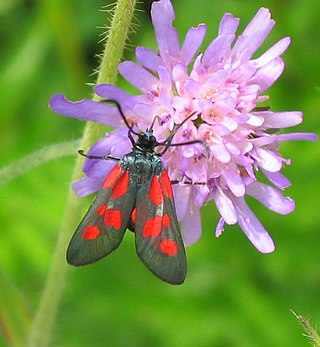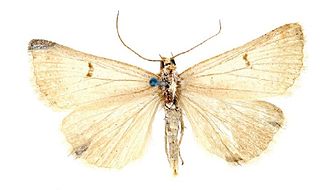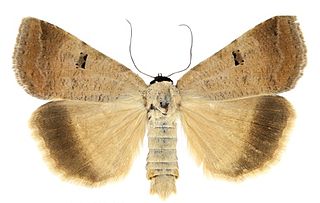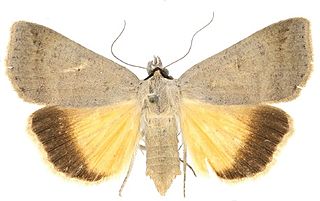
Zygaena viciae, the New Forest burnet moth, is a member of the Zygaenidae family, found in the northern hemisphere. Since 1927 it has been extinct in the New Forest, England, after which it is named. It is also known in Europe as the small five-spotted ram.

Lygephila pastinum, the blackneck, is a moth of the family Erebidae. The species was first described by Georg Friedrich Treitschke in 1826. It is found in Europe and across the Palearctic Siberia, the Russian Far East, Japan and China.

Lygephila is a genus of moths in the family Erebidae. The genus was erected by Gustaf Johan Billberg in 1820.
Toxocampa is a genus of moths of the family Noctuidae. The genus was erected by Achille Guenée in 1841. Lepidoptera and Some Other Life Forms and The Global Lepidoptera Names Index describe this name as a synonym of Lygephila.

Lygephila craccae, the scarce blackneck, is a moth of the family Erebidae. It is found in temperate Europe and across the Palearctic to the Altai Mountains, Korea, Japan and China.

Lygephila lusoria is a moth of the family Erebidae. The species was first described by Carl Linnaeus in his 1758 10th edition of Systema Naturae. It is found in southern Europe, the Near East and Middle East, European south-eastern Russia, the Caucasus, Turkey and Israel.

Lygephila amasina is a moth of the family Erebidae first described by Otto Staudinger in 1878. It is found in Turkey, Lebanon and Israel.

Lygephila colorata is a moth of the family Erebidae first described by János Babics and László Aladár Ronkay in 2009. It is found in north-western Pakistan.

Lygephila pallida is a moth of the family Erebidae first described by Andreas Bang-Haas in 1907. It is found in central and eastern Turkey.

Lygephila fereidun is a moth of the family Erebidae first described by Wiltshire in 1961. It is found in the Elburz Mountains of northern Iran.

Lygephila subpicata is a moth of the family Erebidae first described by Wiltshire in 1971. It is found in northern and western Iran.

Lygephila moellendorffi is a moth of the family Erebidae, genus Lygephila first described by Alfred Otto Herz in 1904. It is found in North Korea.

Lygephila alaica is a moth of the family Erebidae first described by Hans Remm in 1983. It is found in Tajikistan and Uzbekistan.

Lygephila minima is a moth of the family Erebidae first described by Oleg Pekarsky in 2013. It is found in southern Russia and Armenia.

Lygephila lubrica is a moth of the family Erebidae first described by Christian Friedrich Freyer in 1842. It is found from the Zaporizhia region of Ukraine to the Rostov, Samara and Povolzhie regions to the Ural of Russia through Kazakhstan, the Russian Altai to northern Mongolia.

Lygephila lubrosa is a species of moth in the family Erebidae first described by Otto Staudinger in 1901. It is found in Kazakhstan and Tajikistan.

Lygephila kazachkaratavika is a moth of the family Erebidae first described by YuL Stshetkin and YuYu Stshetkin in 1994. It is found in Kazakhstan and Kyrgyzstan.

Lygephila lupina is a moth of the family Erebidae first described by Ludwig Carl Friedrich Graeser in 1890. It is found in the Russian Far East, China and Korea.

Lygephila vulcanea is a moth of the family Erebidae first described by Arthur Gardiner Butler in 1881. It is found in Russia and Japan.

Megoura viciae is a large, green aphid in the family Aphididae native to Europe that feeds on plants in the genus Vicia. They are commonly known as vetch aphids for this reason.


















